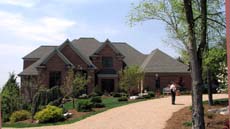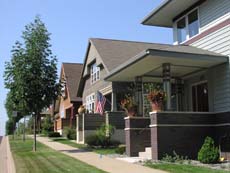New Urbanist regional plans

New York City

Rural sprawl in Virginia

McMansion in suburban Virginia

Houses in Middleton Hills, a New Urbanist development in Wisconsin
Too often, New Urbanism is not understood as a complex system of policies and design principles that operate at multiple scales. It is misinterpreted simply as a conservative movement to recapture the past while ignoring the issues of our time. It is thought to be driven by nostalgia and ordered by outdated tradition. To some, New Urbanism simply means tree-lined streets, houses with front porches, and Main Street retail -- a reworking of a Norman Rockwell fantasy of small-town America, primarily for the rich. If such an oversimplification of New Urbanism were true, this criticism would be compelling. But if nostalgic urbanism is such a good idea, why are so many older, traditional neighborhoods in decline? And given the car, the scale of modern business, and the complex nature of families today, is such a nostalgic vision possible or even desirable? . . . Clearly it is not. But nostalgia is not what New Urbanism is proposing. Its goals and breadth are much grander, more complete and challenging. Many misconceptions are caused by focusing on New Urbanism's neighborhood-scale prescriptions without seeing them embedded in regional structures. . . . Replacing cul-de-sacs and malls with traditional urban design, although desirable, is not sufficient to solve the problems of modern growth, either practically or ideologically. If it were, beautiful and historic Main Streets would not be dying across the country, and many urban neighborhoods would not be in decline. . . .
Two tenets of New Urbanism address these critical issues of affordability and location. One is economic diversity. The other is regionalism. . . . [New Urbanism] advocates mixing income groups and races in a way that frightens many communities. . . . New Urbanism may not always succeed in radically reintegrating the segregated geography of our cities and suburbs, but it does lay out design and policy principles that provide the means to do so. The political will to make such a change consistently involves a larger cultural challenge. . . . Without regional form-givers like habitat and agricultural preserves, urban growth boundaries, transit systems, and designated urban centers, even well-designed neighborhoods can contribute to sprawl. Infill and redevelopment, although a high priority for New Urbanism, cannot accommodate all the growth in many regions. A regional plan is a necessary armature for the placement of new growth."
Calthorpe 2000, 178-80